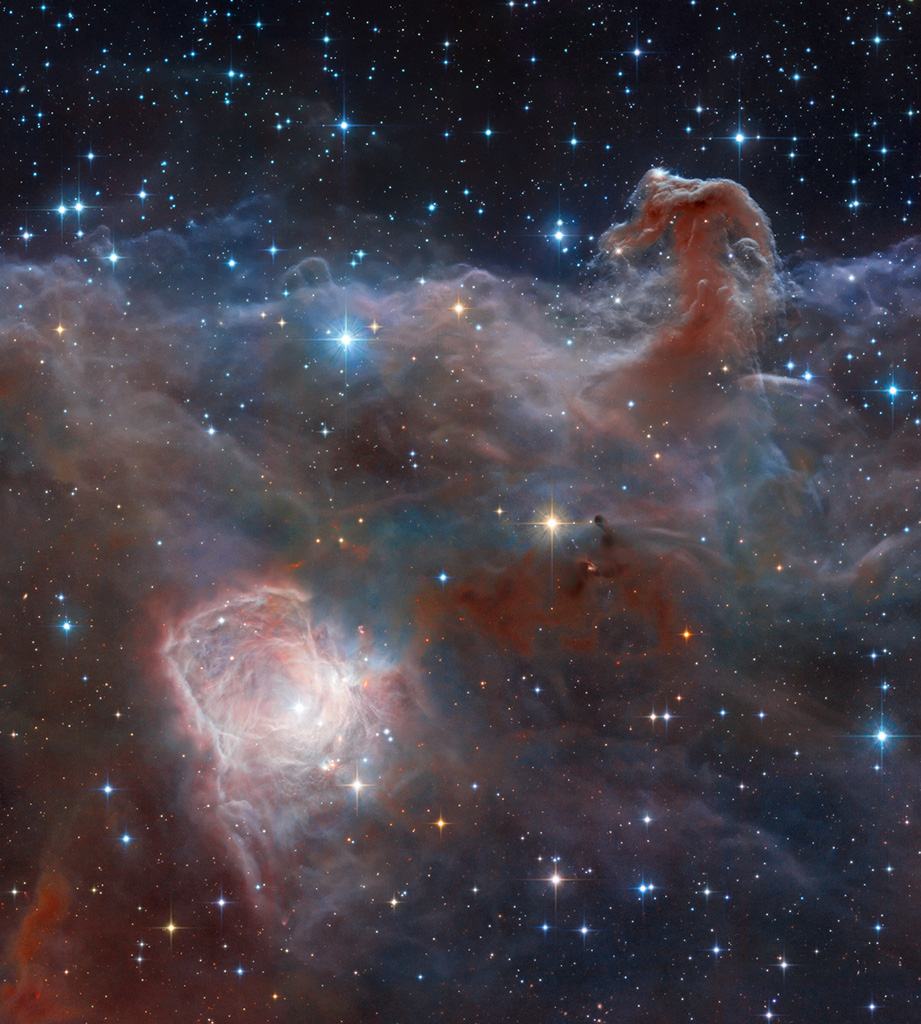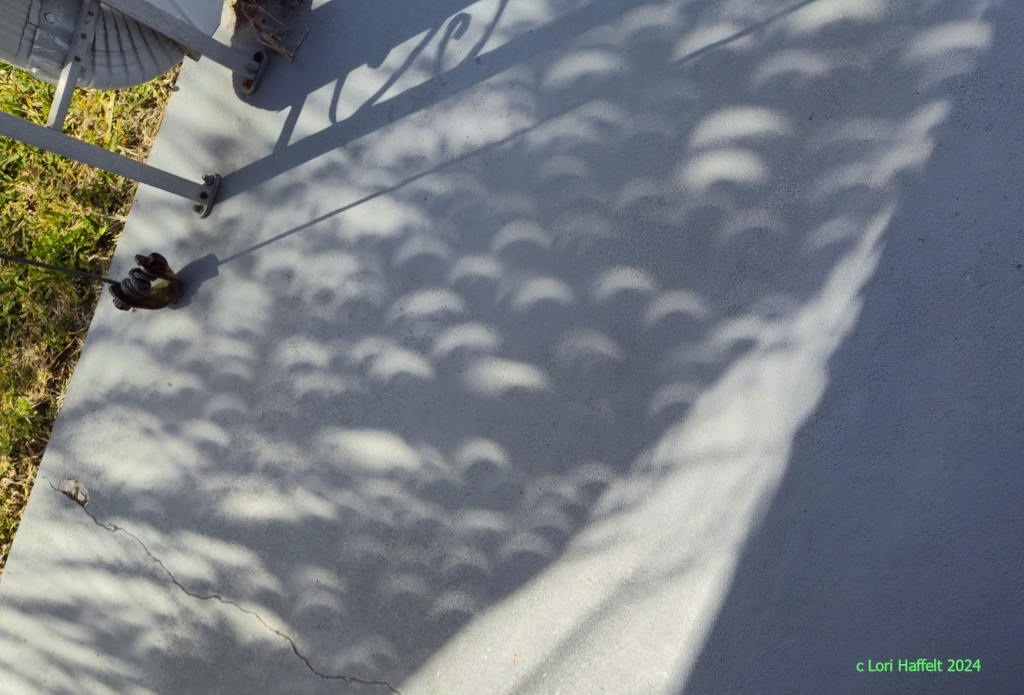
|
| Title: NASA pics | |
| Grapevine50sRoost > ~GENERAL~ > GENERAL DISCUSSION | Go to subcategory: |
| Author | Content |
|
zxxlyzq
|
|
|
Date Posted:09/03/2018 12:10 PMCopy HTML Composition and Processing: Robert Gendler Image Data: ESO, VISTA, HLA, Hubble Heritage Team (STScI/AURA) Explanation: Combined image data from the massive, ground-based VISTA telescope and the Hubble Space Telescope was used to create this wide perspective of the interstellar landscape surrounding the famous Horsehead Nebula. Captured at near-infrared wavelengths, the region's dusty molecular cloud sprawls across the scene that covers an angle about two-thirds the size of the Full Moon on the sky. Left to right the frame spans just over 10 light-years at the Horsehead's estimated distance of 1,600 light-years. Also known as Barnard 33, the still recognizable Horsehead Nebula stands at the upper right, the near-infrared glow of a dusty pillar topped with newborn stars. Below and left, the bright reflection nebula NGC 2023 is itself the illuminated environs of a hot young star. Obscuring clouds below the base of the Horsehead and on the outskirts of NGC 2023 show the tell-tale far red emission of energetic jets, known as Herbig-Haro objects, also associated with newborn stars. |
|
|
Megan57
|
Share to:





 #31
#31
|
|
Re:NASA pics Date Posted:16/09/2025 6:37 AMCopy HTML
|
|
|
Rockymz
|
Share to:





 #32
#32
|
|
Re:NASA pics Date Posted:15/09/2025 8:31 AMCopy HTML Image Credit & Copyright: Lori Haffelt Explanation: Only those along the narrow track of the Moon's shadow on April 8 saw a total solar eclipse. But most of North America still saw a partial eclipse of the Sun. From Clearwater, Florida, USA this single snapshot captured multiple images of that more widely viewed celestial event without observing the Sun directly. In the shade of a palm tree, criss-crossing fronds are projecting recognizable eclipse images on the ground, pinhole camera style. In Clearwater the maximum eclipse phase was about 53 percent. |
|
|
Megan57
|
Share to:





 #33
#33
|
|
Re:NASA pics Date Posted:14/09/2025 8:17 AMCopy HTML
|
|
|
Rockymz
|
Share to:





 #34
#34
|
|
Re:NASA pics Date Posted:14/09/2025 7:42 AMCopy HTML Image Credit: Engraving: Adolf Vollmy; Original Art: Karl Jauslin Explanation: It was a night of 100,000 meteors. The Great Meteor Storm of 1833 was perhaps the most impressive meteor event in recent history. Best visible over eastern North America during the pre-dawn hours of November 13, many people -- including a young Abraham Lincoln -- were woken up to see the sky erupt in streaks and flashes. Hundreds of thousands of meteors blazed across the sky, seemingly pouring out of the constellation of the Lion (Leo). The featured image is a digitization of a wood engraving which itself was based on a painting from a first-person account. We know today that the Great Meteor Storm of 1833 was caused by the Earth moving through a dense part of the dust trail expelled from Comet Tempel-Tuttle. The Earth moves through this dust stream every November during the Leonid meteor shower. Later this week you might get a slight taste of the intensity of that 1833 meteor storm by witnessing the annual Geminid meteor shower. |
|
|
Megan57
|
Share to:





 #35
#35
|
|
Re:NASA pics Date Posted:13/09/2025 6:18 AMCopy HTML
|
|
|
Rockymz
|
Share to:





 #36
#36
|
|
Re:NASA pics Date Posted:12/09/2025 8:32 AMCopy HTML Image Credit & Copyright: North - Zhouyue Zhu, South - Lucy Yunxi Hu Explanation: September's total lunar eclipse is tracked across night skies from both the northern and southern hemispheres of planet Earth in these two dramatic timelapse series. In the northern hemisphere sequence (top panel) the Moon’s trail arcs from the upper left to the lower right. It passes below bright planet Saturn, seen under mostly clear skies from the international campus of Zhejiang University in China at about 30 degrees north latitude. In contrast, the southern hemisphere view from Lake Griffin, Canberra, Australia at 35 degrees south latitude, records the Moon’s trail from the upper right to the lower left. Multiple lightning flashes from thunderstorms near the horizon appear reflected in the lake. Both sequences were photographed with 16mm wide-angle lenses and both cover the entire eclipse, with the darkened red Moon totally immersed in Earth's umbral shadow near center. But the different orientations of the Moon’s path across the sky reveal the perspective shifts caused by the views from northern vs. southern latitudes. |
|
|
Megan57
|
Share to:





 #37
#37
|
|
Re:NASA pics Date Posted:12/09/2025 6:05 AMCopy HTML Amazing Rocky |
|
|
Rockymz
|
Share to:





 #38
#38
|
|
Re:NASA pics Date Posted:11/09/2025 8:21 AMCopy HTML Image Credit & Copyright: Wang Letian (Eyes at Night) Explanation: The dark, inner shadow of planet Earth is called the umbra. Shaped like a cone extending into space, it has a circular cross section most easily seen during a lunar eclipse. And on the night of September 7/8 the Full Moon passed near the center of Earth's umbral cone, entertaining eclipse watchers around much of our fair planet, including parts of Antarctica, Australia, Asia, Europe, and Africa. Recorded from Zhangjiakou City, China, this timelapse composite image uses successive pictures from the total lunar eclipse, progressing left to right, to reveal the curved cross-section of the umbral shadow sliding across the Moon. Sunlight scattered by the atmosphere into Earth's umbra causes the lunar surface to appear reddened during totality. But close to the umbra's edge, the limb of the eclipsed Moon shows a distinct blue hue. The blue eclipsed moonlight originates as rays of sunlight pass through layers high in the upper stratosphere, colored by ozone that scatters red light and transmits blue. In the total phase of this leisurely lunar eclipse, the Moon was completely within the Earth's umbra for about 83 minutes. |
|
|
Megan57
|
Share to:





 #39
#39
|
|
Re:NASA pics Date Posted:11/09/2025 6:20 AMCopy HTML
|
|
|
Rockymz
|
Share to:





 #40
#40
|
|
Re:NASA pics Date Posted:10/09/2025 8:40 AMCopy HTML Image Credit & Copyright: Ian Moehring & Kevin Roylance Explanation: It is one of the largest nebulas on the sky -- why isn't it better known? Roughly the same angular size as the Andromeda Galaxy, the Great Lacerta Nebula can be found toward the constellation of the Lizard (Lacerta). The emission nebula is difficult to see with wide-field binoculars because it is so faint, but also usually difficult to see with a large telescope because it is so great in angle -- spanning about three degrees. The depth, breadth, waves, and beauty of the nebula -- cataloged as Sharpless 126 (Sh2-126) -- can best be seen and appreciated with a long duration camera exposure. The featured image is one such combined exposure -- in this case taken over three nights in August through dark skies in Moses Lake, Washington, USA. The hydrogen gas in the Great Lacerta Nebula glows red because it is excited by light from the bright star 10 Lacertae, one of the bright blue stars just to the left of the red-glowing nebula's center. Most of the stars and nebula are about 1,200 light years distant. |
|
|
Megan57
|
Share to:





 #41
#41
|
|
Re:NASA pics Date Posted:09/09/2025 5:57 AMCopy HTML Was going to say looks like a butterfly |
|
|
Rockymz
|
Share to:





 #42
#42
|
|
Re:NASA pics Date Posted:08/09/2025 8:27 AMCopy HTML Image Credit: NASA, ESA, CSA, Webb; Processing: M. Villenave et al. Explanation: This butterfly can hatch planets. The nebula fanning out from the star IRAS 04302+2247 may look like the wings of a butterfly, while the vertical brown stripe down the center may look like the butterfly's body -- but together they indicate an active planet-forming system. The featured picture was captured recently in infrared light by the Webb Space Telescope. Pictured, the vertical disk is thick with the gas and dust from which planets form. The disk shades visible and (most) infrared light from the central star, allowing a good view of the surrounding dust that reflects out light. In the next few million years, the dust disk will likely fragment into rings through the gravity of newly hatched planets. And a billion years from now, the remaining gas and dust will likely dissipate, leaving mainly the planets -- like in our Solar System. |
|
|
Megan57
|
Share to:





 #43
#43
|
|
Re:NASA pics Date Posted:08/09/2025 6:22 AMCopy HTML
|
|
|
Rockymz
|
Share to:





 #44
#44
|
|
Re:NASA pics Date Posted:07/09/2025 9:47 AMCopy HTML Illustration Credit: Jack Cook, Adam Nieman, Woods Hole Oceanographic Institution; Data source: Igor Shiklomanov Explanation: How much of planet Earth is made of water? Very little, actually. Although oceans of water cover about 70 percent of Earth's surface, these oceans are shallow compared to the Earth's radius. The featured illustration shows what would happen if all of the water on or near the surface of the Earth were bunched up into a ball. The radius of this ball would be only about 700 kilometers, less than half the radius of the Earth's Moon, but slightly larger than Saturn's moon Rhea which, like many moons in our outer Solar System, is mostly water ice. The next smallest ball depicts all of Earth's liquid fresh water, while the tiniest ball shows the volume of all of Earth's fresh-water lakes and rivers. How any of this water came to be on the Earth and whether any significant amount is trapped far beneath Earth's surface remain topics of research. |
|
|
Megan57
|
Share to:





 #45
#45
|
|
Re:NASA pics Date Posted:07/09/2025 7:28 AMCopy HTML
|
|
|
Rockymz
|
Share to:





 #46
#46
|
|
Re:NASA pics Date Posted:06/09/2025 9:09 AMCopy HTML Image Credit & Copyright: Lorenzo Busilacchi Explanation: When the sun sets on September 7, the Full Moon will rise. And on that date denizens around much of our fair planet, including parts of Antarctica, Australia, Asia, Europe, and Africa can witness a total lunar eclipse, with the Moon completely immersed in Earth's shadow. As the bright Full Moon first enters Earth's shadow it will darken, finally taking on a reddish hue during the total eclipse phase. In fact, the color of the Moon during a total lunar eclipse is due to reddened light from sunrises and sunsets around planet Earth. The reddened sunlight is scattered by a dense atmosphere into the planet's otherwise dark central shadow. When the sun set on August 22, this telephoto snapshot of red skies, blue sea, and the Mangiabarche Lighthouse was captured from Sant'Antioco, Sardinia, Italy. |
|
|
Megan57
|
Share to:





 #47
#47
|
|
Re:NASA pics Date Posted:05/09/2025 8:27 AMCopy HTML
|
|
|
Rockymz
|
Share to:





 #48
#48
|
|
Re:NASA pics Date Posted:05/09/2025 8:08 AMCopy HTML Image Credit & Copyright: Carlos Taylor Explanation: Also known as NGC 104, 47 Tucanae is a jewel of the southern sky. Not a star but a dense cluster of stars, it roams the halo of our Milky Way Galaxy along with some 200 other globular star clusters. The second brightest globular cluster (after Omega Centauri) as seen from planet Earth, 47 Tuc lies about 13,000 light-years away. It can be spotted with the naked eye close on the sky to the Small Magellanic Cloud in the constellation of the Toucan. The dense cluster is made up of hundreds of thousands of stars in a volume only about 120 light-years across. Red giant stars on the outskirts of the cluster are easy to pick out as yellowish stars in this sharp telescopic portrait. Tightly packed globular star cluster 47 Tuc is also home to a star with the closest known orbit around a black hole. |
|
|
Rockymz
|
Share to:





 #49
#49
|
|
Re:NASA pics Date Posted:04/09/2025 8:31 AMCopy HTML Image Credit & Copyright: José Rodrigues (IA, OFXB) Explanation: Magnificent spiral galaxy NGC 4565 is viewed edge-on from planet Earth. Also known as the Needle Galaxy for its narrow profile, bright NGC 4565 is a stop on many telescopic tours of the northern sky, in the faint but well-groomed constellation Coma Berenices. This sharp, colorful image reveals the galaxy's boxy, bulging central core cut by obscuring dust lanes that lace NGC 4565's thin galactic plane. NGC 4565 lies around 40 million light-years distant while the spiral galaxy itself spans some 100,000 light-years. That's about the size of our own Milky Way. Easily spotted with small telescopes, deep sky enthusiasts consider NGC 4565 to be a prominent celestial masterpiece Messier missed. |
|
|
Megan57
|
Share to:





 #50
#50
|
|
Re:NASA pics Date Posted:04/09/2025 6:42 AMCopy HTML
|
|
|
Rockymz
|
Share to:





 #51
#51
|
|
Re:NASA pics Date Posted:03/09/2025 7:38 AMCopy HTML
Image Credit: J. English (U. Manitoba) & K. Gasealahwe (U. Cape Town), SARAO, MeerKAT, ThunderKAT; Science: K. Gasealahwe, K. Savard (U. Oxford) et al.; Text: J. English & K. Savard Explanation: How soon do jets form when a supernova gives birth to a neutron star? The Africa Nebula provides clues. This supernova remnant surrounds Circinus X-1, an X-ray emitting neutron star and the companion star it orbits. The image, from the ThunderKAT collaboration on the MeerKAT radio telescope situated in South Africa, shows the bright core-and-lobe structure of Cir X-1’s currently active jets inside the nebula. A mere 4600 years old, Cir X-1 could be the "Little Sister" of microquasar SS 433*. However, the newly discovered bubble exiting from a ring-like hole in the upper right of the nebula, along with a ring to the bottom left, demonstrate that other jets previously existed. Computer simulations indicate those jets formed within 100 years of the explosion and lasted up to 1000 years. Surprisingly, to create the observed bubble, the jets need to be more powerful than young neutron stars were previously thought to produce. |
|
|
Megan57
|
Share to:





 #52
#52
|
|
Re:NASA pics Date Posted:02/09/2025 8:12 AMCopy HTML Amazing Rocky thank you x |
|
|
Rockymz
|
Share to:





 #53
#53
|
|
Re:NASA pics Date Posted:02/09/2025 8:00 AMCopy HTML
Image Credit & Copyright: Daniel Stern Explanation: The Horsehead Nebula is one of the most famous nebulae on the sky. It is visible as the dark indentation to the orange emission nebula at the far right of the featured picture. The horse-head feature is dark because it is really an opaque dust cloud that lies in front of the bright emission nebula. Like clouds in Earth's atmosphere, this cosmic cloud has assumed a recognizable shape by chance. After many thousands of years, the internal motions of the cloud will surely alter its appearance. The emission nebula's orange color is caused by electrons recombining with protons to form hydrogen atoms. Toward the lower left of the image is the Flame Nebula, an orange-tinged nebula that also contains intricate filaments of dark dust. |
|
|
Rockymz
|
Share to:





 #54
#54
|
|
Re:NASA pics Date Posted:01/09/2025 7:50 AMCopy HTML Image Credit: NASA, JPL-Caltech, Voyager 2; Processing & License: Kevin M. Gill; Explanation: Its surface is the most densely cratered in the Solar System -- but what's inside? Jupiter's moon Callisto is a battered ball of dirty ice that is larger than the planet Mercury. It was visited by NASA's Galileo spacecraft in the 1990s and 2000s, but the recently reprocessed featured image is from a flyby of NASA's Voyager 2 in 1979. The moon would appear darker if it weren't for the tapestry of light-colored fractured surface ice created by eons of impacts. The interior of Callisto is potentially even more interesting because therein might lie an internal layer of liquid water. This potential underground sea is a candidate to harbor life -- similar with sister moons Europa and Ganymede. Callisto is slightly larger than Luna, Earth's Moon, but because of its high ice content is slightly less massive. ESA's JUICE and NASA's Europa Clipper missions are now headed out to Jupiter to better investigate its largest moons. |
|
|
Megan57
|
Share to:





 #55
#55
|
|
Re:NASA pics Date Posted:01/09/2025 5:49 AMCopy HTML
|
|
|
Rockymz
|
Share to:





 #56
#56
|
|
Re:NASA pics Date Posted:31/08/2025 7:25 AMCopy HTML Image Credit: NASA, ESA, Hubble; Processing: Delio Tolivia Cadrecha Explanation: What created this unusual planetary nebula? Dubbed the Pillow Nebula and the Flying Carpet Nebula, NGC 7027 is one of the smallest, brightest, and most unusually shaped planetary nebulas known. Given its expansion rate, NGC 7027 first started expanding, as visible from Earth, about 600 years ago. For much of its history, the planetary nebula has been expelling shells, as seen in blue in the featured image by the Hubble Space Telescope. In modern times, though, for reasons unknown, it began ejecting gas and dust (seen in brown) in specific directions that created a new pattern that seems to have four corners. What lies at the nebula's center is unknown, with one hypothesis holding it to be a close binary star system where one star sheds gas onto an erratic disk orbiting the other star. NGC 7027, about 3,000 light years away, was first discovered in 1878 and can be seen with a standard backyard telescope toward the constellation of the Swan (Cygnus). |
|
|
Megan57
|
Share to:





 #57
#57
|
|
Re:NASA pics Date Posted:31/08/2025 7:13 AMCopy HTML
|
|
|
Rockymz
|
Share to:





 #58
#58
|
|
Re:NASA pics Date Posted:30/08/2025 8:48 AMCopy HTML Image Credit & Copyright: Marina Prol Explanation: A young crescent moon can be hard to see. That's because when the Moon shows it's crescent phase (young or old) it can never be far from the Sun in planet Earth's sky. And even though the sky is still bright, a slender sunlit lunar crescent is cleary visible in this early evening skyscape. The telephoto snapshot was captured on August 24, with the Moon very near the western horizon at sunset. Seen in a narrow crescent phase about 1.5 days old, the visible sunlit portion is a mere two percent of the surface of the Moon's familiar nearside. At the Canary Islands Space Centre, a steerable radio dish for communication with spacecraft is titled in the direction of the two percent Moon. The sunset sky's pastel pinkish coloring is partly due to fine sand and dust from the Sahara Desert blown by the prevailing winds. |
|
|
Rockymz
|
Share to:





 #59
#59
|
|
Re:NASA pics Date Posted:29/08/2025 8:02 AMCopy HTML Image Credit & Copyright: Katelyn Beecroft Explanation: The diffuse hydrogen-alpha glow of emission region Sh2-27 fills this cosmic scene. The field of view spans nearly 3 degrees across the nebula-rich constellation Ophiuchus toward the central Milky Way. A Dark Veil of wispy interstellar dust clouds draped across the foreground is chiefly identified as LDN 234 and LDN 204 from the 1962 Catalog of Dark Nebulae by American astronomer Beverly Lynds. Sh2-27 itself is the large but faint HII region surrounding runaway O-type star Zeta Ophiuchi. Along with the Zeta Oph HII region, LDN 234 and LDN 204 are likely 500 or so light-years away. At that distance, this telescopic frame would be about 25 light-years wide. |
|
|
Megan57
|
Share to:





 #60
#60
|
|
Re:NASA pics Date Posted:29/08/2025 5:49 AMCopy HTML
|




































